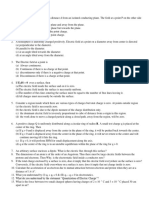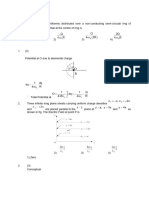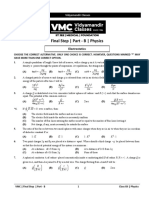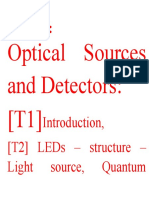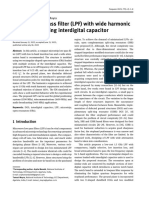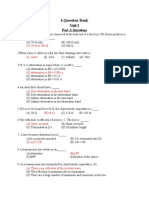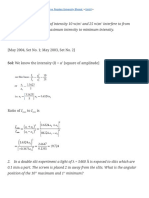Test: Unit 1
Type A: 1 Mark Question
1. A hemisphere is uniformly charged positively. The electric field at a point on a diameter away from the centre is directed
(a) perpendicular to the diameter (b) parallel to the diameter
(c) at an angle tilted towards the diameter (d) at an angle tilted away from the diameter.
2. If s .d = 0 ∫ E S over a surface, then
(a) the electric field inside the surface and on it is zero.
(b) the electric field inside the surface is necessarily uniform.
(c) the number of flux lines entering the surface must be equal to the number of flux lines leaving it.
(d) all charges must necessarily be outside the surface.
3. Consider a region inside which there are various types of charges but the total charge is zero. At points outside the region
(a) the electric field is necessarily zero.
(b) the electric field is due to the dipole moment of the charge distribution only.
(c) the dominant electric field is 1/r3, for large r, where r is the distance from a origin in this region.
(d) the work done to move a charged particle along a closed path, away from the region, will be zero.
4. A positively charged particle is released from rest in an uniform electric field. The electric potential energy of the charge
(a) remains a constant because the electric field is uniform.
(b) increases because the charge moves along the electric field.
(c) decreases because the charge moves along the electric field.
(d) decreases because the charge moves opposite to the electric field.
5. The electrostatic potential on the surface of a charged conducting sphere is 100V. Two statements are made in this regard:
S1 : At any point inside the sphere, electric intensity is zero.
S2 : At any point inside the sphere, the electrostatic potential is 100V.
Which of the following is a correct statement?
(a) S1 is true but S2 is false.
(b) Both S1 & S2 are false.
(c) S1 is true, S2 is also true and S1 is the cause of S2.
(d) S1 is true, S2 is also true but the statements are independent.
6. Equipotentials at a great distance from a collection of charges whose total sum is not zero are approximately
(a) spheres. (b) planes. (c) paraboloids (d) ellipsoids.
7. Consider a uniform electric field in the zˆ direction. The potential is a constant
(a) in all space. (b) for any x for a given z.
(c) for any y for a given z. (d) on the x-y plane for a given z.
8. Equipotential surfaces
(a) are closer in regions of large electric fields compared to regions of lower electric fields.
(b) will be more crowded near sharp edges of a conductor.
(c) will be more crowded near regions of large charge densities.
(d) will always be equally spaced.
9. The work done to move a charge along an equipotential from A to B
B B
10. (a) cannot be defined as - ∫ E . dl (b) must be defined as - ∫ E . dl
A A
(c) is zero. (d) can have a non-zero value.
11. In a region of constant potential
(a) the electric field is uniform
(b) the electric field is zero
(c) there can be no charge inside the region.
(d) the electric field shall necessarily change if a charge is placed outside the region.
12. If a conductor has a potential V ≠ 0 and there are no charges anywhere else outside, then
(a) there must be charges on the surface or inside itself.
(b) there cannot be any charge in the body of the conductor.
(c) there must be charges only on the surface.
(d) there must be charges inside the surface.
�13. A positive charge Q is uniformly distributed along a circular ring of radius R. A small test charge q is placed at the centre of
the ring as shown in the figure. Then
(a) If q > 0 and is displaced away from the centre in the plane of the ring, it will be pushed back towards the centre.
(b) If q < 0 and is displaced away from the centre in the plane of the ring, it will never return to the centre and will continue
moving till it hits the ring.
(c) If q < 0, it will perform SHM for small displacement along the axis.
(d) q at the centre of the ring is in an unstable equilibrium within the plane of the ring for q > 0.
14. Why there is no work done in moving a charge from one point to another on an equipotential surface?
15. A hollow metal sphere of radius 5 cm is charged such that potential on its surface is 10V. What is potential at the centre of
the sphere?
Type B: 2 Marks Questions
16. The dimensions of an atom are of the order of an Angstrom. Thus there must be large electric fields between the protons and
electrons. Why, then is the electrostatic field inside a conductor zero?
17. If the total charge enclosed by a surface is zero, does it imply that the electric field everywhere on the surface is zero?
Conversely, if the electric field everywhere on a surface is zero, does it imply that net charge inside is zero.
18. Two charges q and –3q are placed fixed on x-axis separated by distance‘d’. Where a third charge 2q should be placed such
that it will not experience any force?
19. Two point charges 3 μC and -3 μC are placed at points A and B, 5cm apart (i) draw the equipotential surface of this system
(ii) Why do equipotential surfaces get close to each other near the point charge?
20. Two point charges q1 = 10x10-8 C and q2 = 2 x 10-8 C are separated by the distance of 60 cm in air (i) what is the distance of
the first charge q1 would the electric potential is zero? (ii) calculate the electric potential energy of the system?
Type C: 3 Marks Questions
21. Using Gauss’s Law, obtain the expression for the electric field due to the uniformly charged spherical shell of radius R at a
point outside the shell. Draw a graph showing the variations of electric field with ‘r’ for r > R and r < R.
22. A parallel plate capacitor, each with plate area A and separation ‘d’ is charged to a potential difference. The battery used to
charge it remains connected. A dielectric slab of thickness ‘d’ and dielectric constant K is now placed between the plates.
What change if any take place in (i) charge on plates? (ii) Electric field intensity between the plates (iii) capacitance of the
capacitor? Justify your answer?
23. Define the term (i) capacitance of a capacitor (ii) dielectric strength of the dielectric (iii) when a dielectric is inserted between
the plates of a charged parallel plate capacitor fully occupying the intervening region, how does the polarization of the
dielectric medium affect the net electric field? For a linear dielectric, show that the introduction of the dielectric increases its
capacity by a factor K which is the characteristics of the dielectric.






















